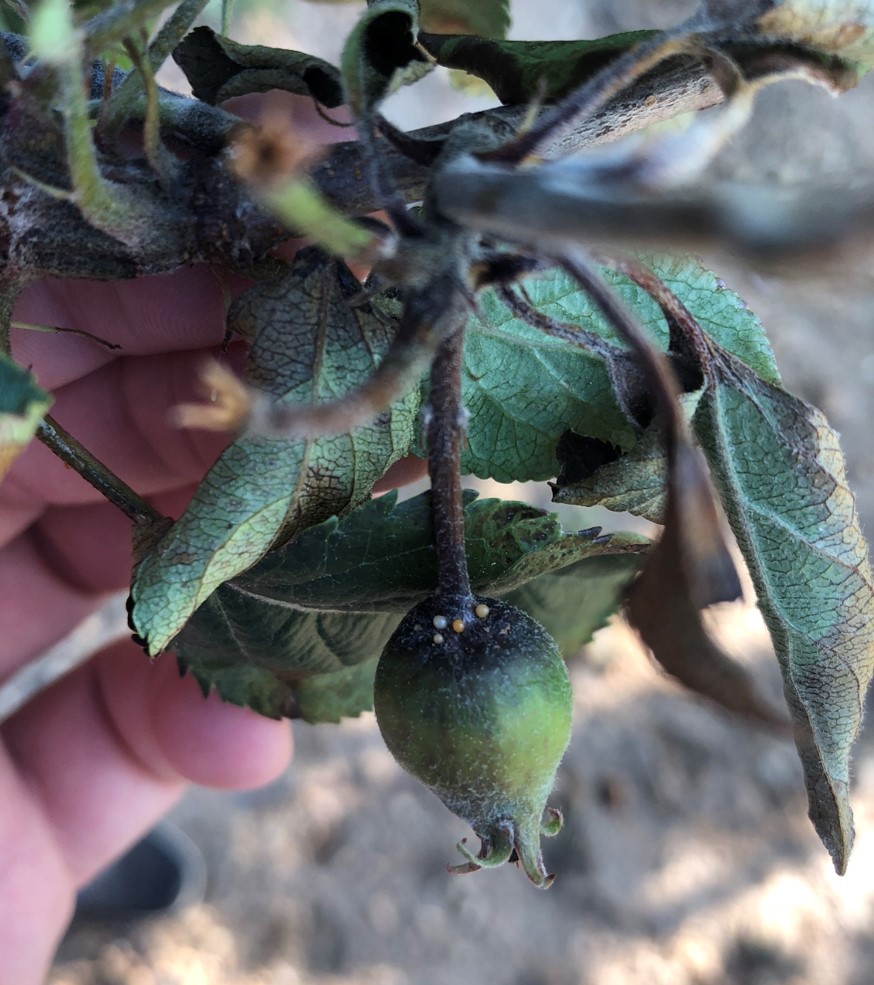Apple Disease Update: Week of May 27
go.ncsu.edu/readext?529757
en Español / em Português
El inglés es el idioma de control de esta página. En la medida en que haya algún conflicto entre la traducción al inglés y la traducción, el inglés prevalece.
Al hacer clic en el enlace de traducción se activa un servicio de traducción gratuito para convertir la página al español. Al igual que con cualquier traducción por Internet, la conversión no es sensible al contexto y puede que no traduzca el texto en su significado original. NC State Extension no garantiza la exactitud del texto traducido. Por favor, tenga en cuenta que algunas aplicaciones y/o servicios pueden no funcionar como se espera cuando se traducen.
Português
Inglês é o idioma de controle desta página. Na medida que haja algum conflito entre o texto original em Inglês e a tradução, o Inglês prevalece.
Ao clicar no link de tradução, um serviço gratuito de tradução será ativado para converter a página para o Português. Como em qualquer tradução pela internet, a conversão não é sensivel ao contexto e pode não ocorrer a tradução para o significado orginal. O serviço de Extensão da Carolina do Norte (NC State Extension) não garante a exatidão do texto traduzido. Por favor, observe que algumas funções ou serviços podem não funcionar como esperado após a tradução.
English
English is the controlling language of this page. To the extent there is any conflict between the English text and the translation, English controls.
Clicking on the translation link activates a free translation service to convert the page to Spanish. As with any Internet translation, the conversion is not context-sensitive and may not translate the text to its original meaning. NC State Extension does not guarantee the accuracy of the translated text. Please note that some applications and/or services may not function as expected when translated.
Collapse ▲The Good News: The sun came out last week to enable fungicide applications to be made in Western NC.
The Bad News: With the exception of the Brushy Mountain growing region, after this weekend (2+ inches of rain) very little residues are likely left on the trees.
The Additional Bad News: An additional 4 inches of rain are predicted over the next 3 days (5/29-5/31).
My Advice: If you can get a break from the rain (or at least to a point where it is misting or gently raining) apply a full rate of captan + 4 pts ProPhyt (or a similar phosphorous acid fungicide) prioritizing: 1) Glomerella leaf spot/fruit rot susceptible cultivars in blocks with a history of the disease; 2) Glomerella leaf spot/fruit rot susceptible cultivars in blocks with no history of the disease; 3) Blocks in which bitter rot is typically observed; 4) Everything else. For late harvest cultivars such as ‘Pink Lady’ I also strongly advise including a half rate of mancozeb (3 lb/A) in the application. Applying a locally systemic, single-site fungicide in the rain or without having ample time to dry, is not advised. If conditions are such that you cannot get a fungicide application on before or during this next onslaught of rain, prioritize as above, and apply Merivon or Pristine in tank mixture with captan, mancozeb or both. You may get 24 applications of kick-back activity using these products. Other FRAC 11 containing fungicides such as Flint (trifloxystrobin) have not demonstrated high efficacy in the curative mode during studies in the lab.
Glomerella and Bitter Rot are on the Brain, but Don’t Forget About…….
- Fire Blight
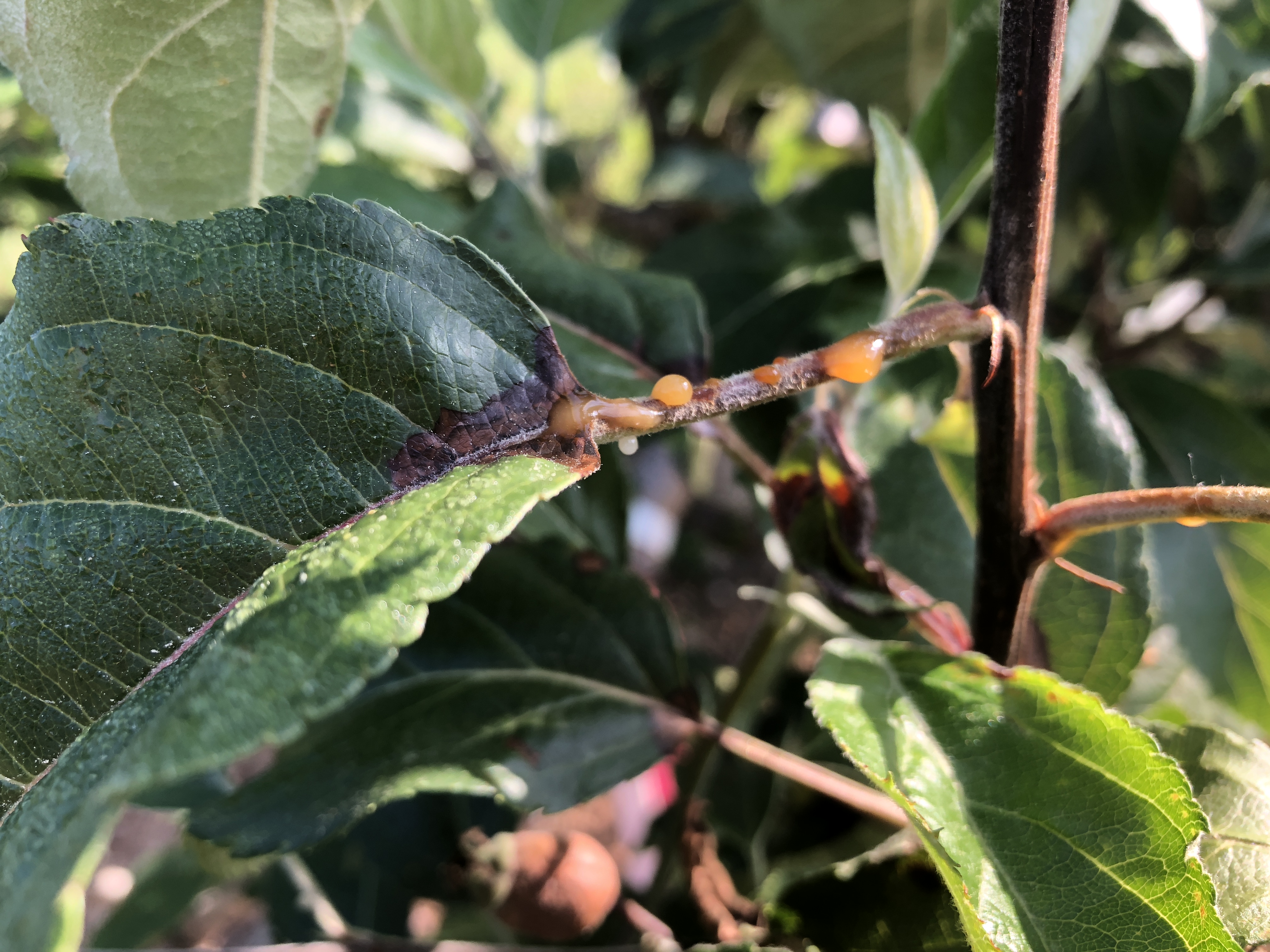 The risk of shoot blight will continue until terminal bud set has occurred. The importance of prohexadione calcium applications for the prevention of shoot blight has been covered in detail in several previous “Apple Disease Updates”. For a review of shoot blight management including rescue program and new planting options see the post on 1st Cover Disease Management.
The risk of shoot blight will continue until terminal bud set has occurred. The importance of prohexadione calcium applications for the prevention of shoot blight has been covered in detail in several previous “Apple Disease Updates”. For a review of shoot blight management including rescue program and new planting options see the post on 1st Cover Disease Management. - Apple Scab
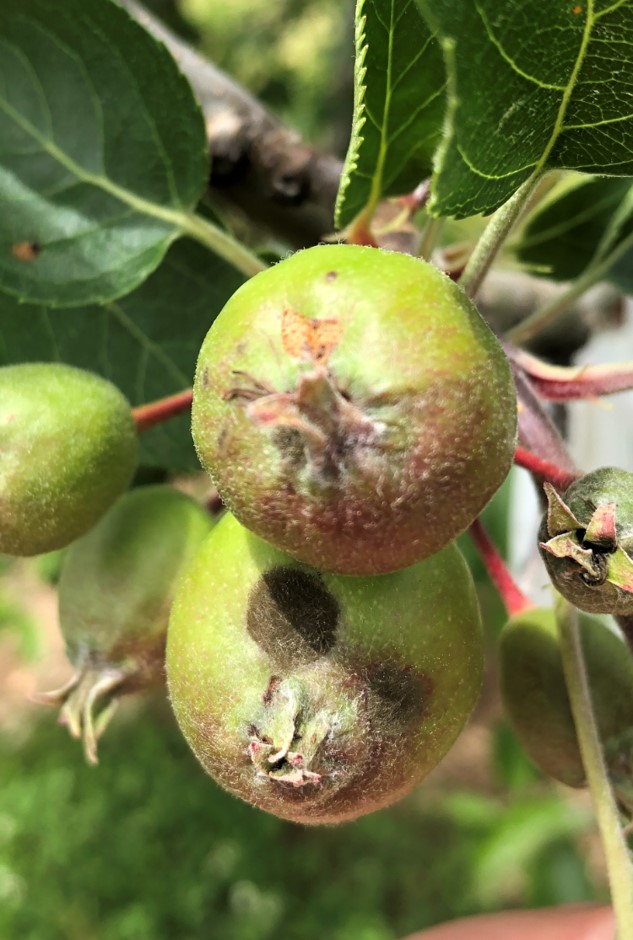 Conditions remain ideal for secondary scab infections. For management, I suggest applying a locally systemic single-site fungicide with a half rate of a protectant fungicide (captan, ziram, mancozeb) for resistance management. Some options include:
Conditions remain ideal for secondary scab infections. For management, I suggest applying a locally systemic single-site fungicide with a half rate of a protectant fungicide (captan, ziram, mancozeb) for resistance management. Some options include:
- FRAC 7: Aprovia, Sercadis (an a.i. in Merivon), Fontelis (no reports of resistance in scab populations in the eastern US)
- FRAC 11: Flint, Sovran
- FRAC 7 + 11 (pre-mixed products): Merivon, Luna Sensation, Pristine
- FRAC 3: Inspire Super, Indar 2F, Topguard, Rally 40WSP. Resistance to Rally and Topguard is fairly prevalent in the eastern US. Inspire Super and Indar have greater inherent efficacy against the apple scab pathogen and may still work in orchards resistant to products like Topguard or Rally. Make sure to apply the highest labeled rate.
- Cedar /Quince/Hawthorn Apple Rust
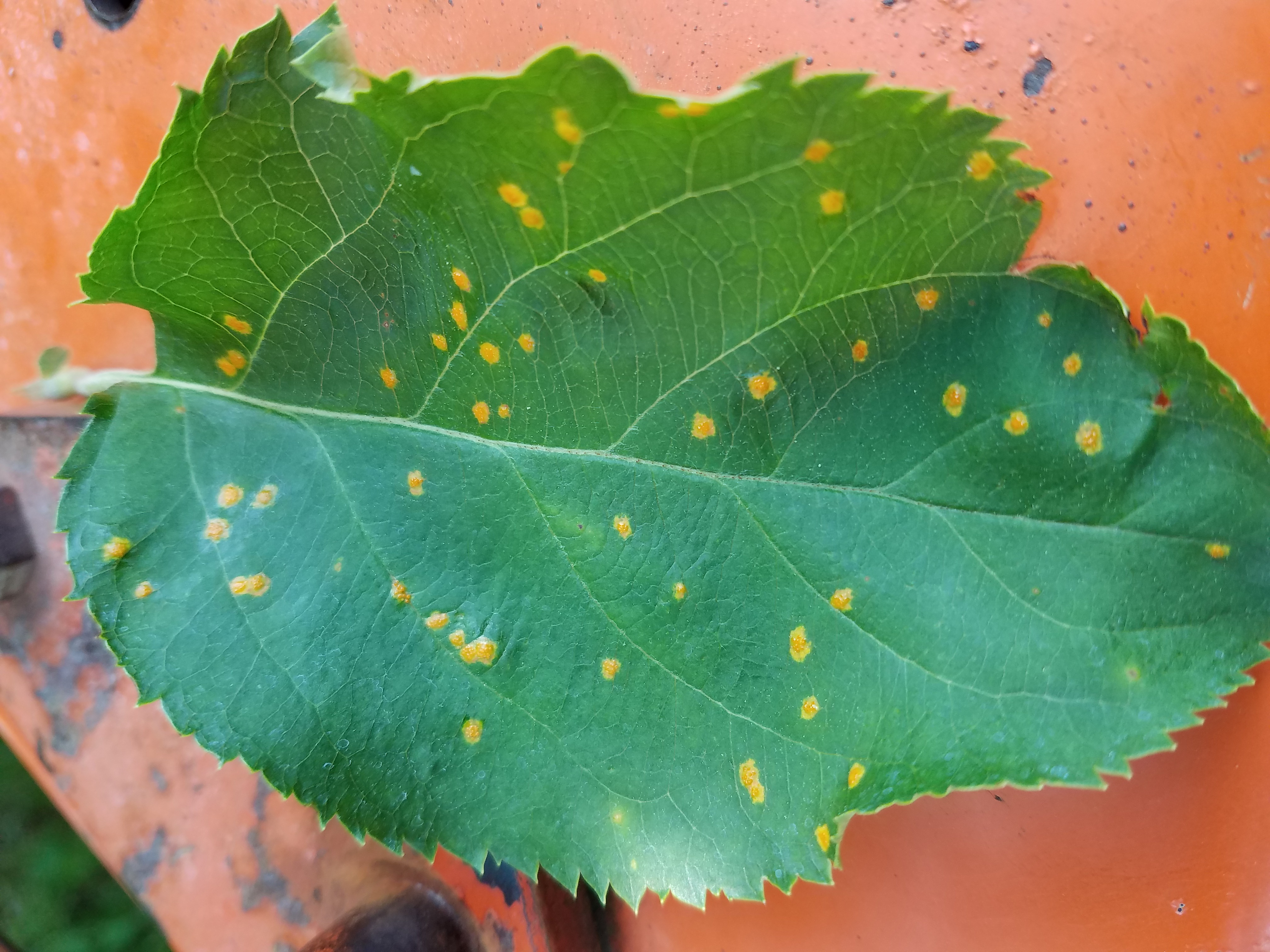 A grower sent this photo of apple rust my way this weekend. There have been several reports of apple rust in the region with foliar symptoms similar to what you see above. Unlike diseases like apple scab which have a secondary/repeating cycle on the apple host, there is no secondary cycle on apples when it comes to Cedar, Quince, or Hawthorn Apple Rusts. Rather, spores that are released by the rust pathogens will infect their alternate hosts later in the growing season. Although infections to apple have most likely occurred, if you are seeing yellow spots on leaves popping up throughout your orchard you may be able to slow down lesion development on leaves and fruit with S.I. (FRAC 3) fungicides. Keep in mind, these fungicides will not provide acceptable levels of control against Glomerella/bitter rot.
A grower sent this photo of apple rust my way this weekend. There have been several reports of apple rust in the region with foliar symptoms similar to what you see above. Unlike diseases like apple scab which have a secondary/repeating cycle on the apple host, there is no secondary cycle on apples when it comes to Cedar, Quince, or Hawthorn Apple Rusts. Rather, spores that are released by the rust pathogens will infect their alternate hosts later in the growing season. Although infections to apple have most likely occurred, if you are seeing yellow spots on leaves popping up throughout your orchard you may be able to slow down lesion development on leaves and fruit with S.I. (FRAC 3) fungicides. Keep in mind, these fungicides will not provide acceptable levels of control against Glomerella/bitter rot.
- Powdery Mildew
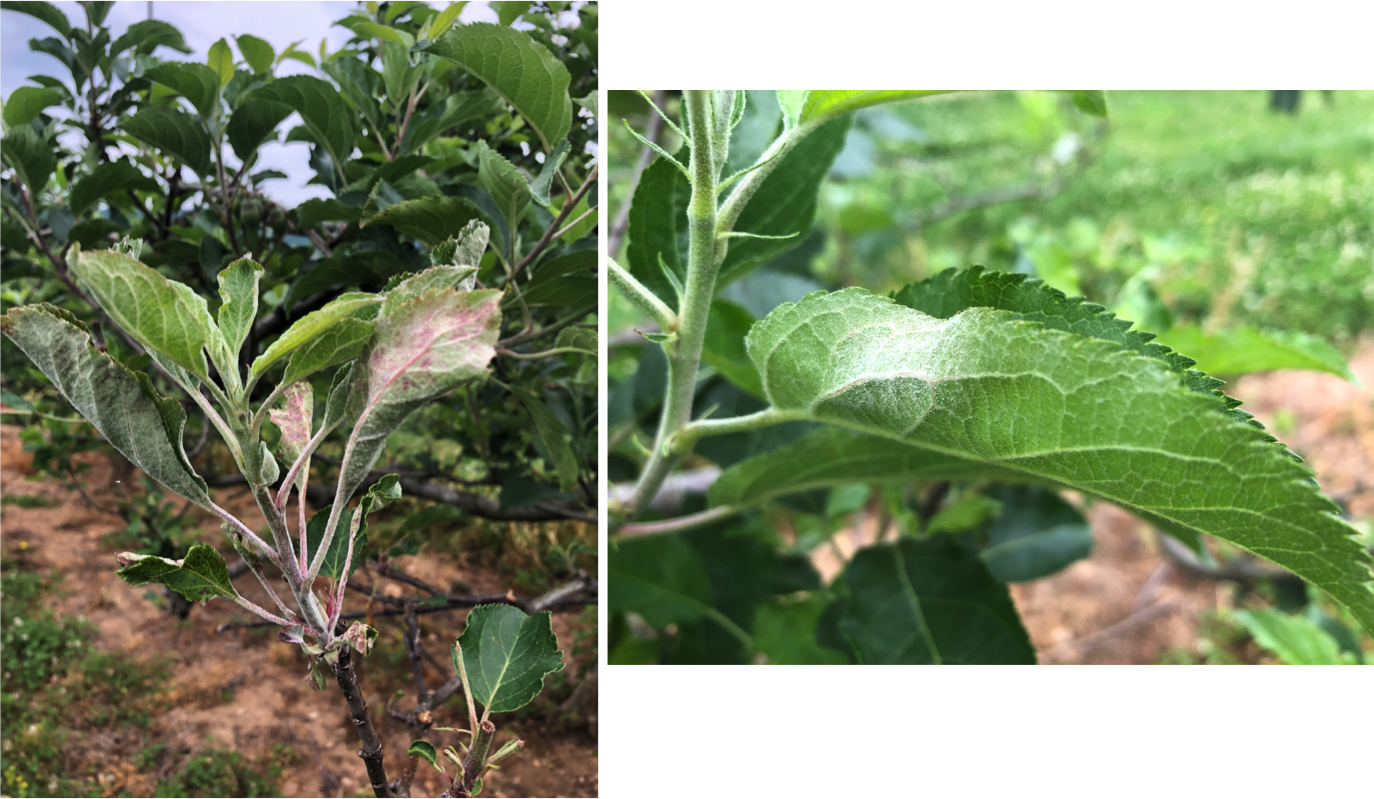 Although the powdery mildew fungus does not love standing water for germination, humid and hot conditions do favor infection and disease development. If powdery mildew is a concern, consider the following:
Although the powdery mildew fungus does not love standing water for germination, humid and hot conditions do favor infection and disease development. If powdery mildew is a concern, consider the following:
- Protectant fungicides such as captan and mancozeb provide little to no efficacy against the disease
- S.I. (FRAC 3 fungicides) vary in efficacy against powdery mildew. Topguard, Rally 40WSP, and Procure have demonstrated the highest levels of powdery mildew control in field trials, whereas Inspire Super and Indar 2F (better on scab) have not performed as well against apple powdery mildew.
- Strobilurin (FRAC 11) stand-alone fungicides such as Sovran and Flint, or pre-mix products containing strobiliurins (e.g. Luna Sensation and Merivon) tend to have excellent activity against apple powdery mildew
- Under high disease pressure, the SDHIs (FRAC 7) have moderate activity against apple powdery mildew. If powdery mildew is your primary target I would consider an alternative class.
- Sulfur is also an excellent product for apple powdery mildew management. Make sure to read the label regarding phytotoxicity and tank mixtures!



